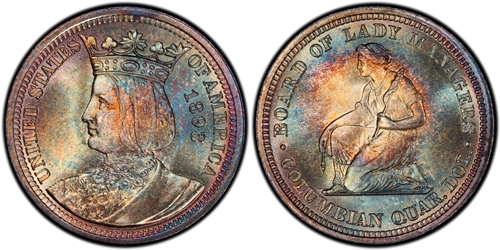
The Isabella Quarter Dollar 1893
The Columbian Exposition was run by a group called the Board of Gentleman Mangers. This situation was totally unacceptable to Susan B Anthony and the National American Woman’s Suffrage Association. So with their agitation a Board of Lady Managers was created.
Unfortunately, or maybe fortunately, the Board of Lady Managers was made subordinate to the Board of Gentleman Managers. The Ladies board was not populated by management types, but rather by Chicago Society Ladies and Moralists. The Gentleman’s Board tended to overrule most of the Lady’s decisions. One decision that it was good they overruled was their decision to evict the Egyptian Village girls and especially Little Egypt. This was one of the few exhibits at the exposition that was actually making money. Eventually the Ladies Board did little more than run the Women’s Building and a few exhibits by women. One other thing they did do was to have a try at fundraising.
It was felt that since the Gentleman had a coin they needed one as well. In response the government authorized $10,000 face value in quarter dollars. The coins depicted on the obverse a fanciful portrait of Queen Isabella of Spain (Although it could just as well have been the chairman of the Board of Lady Managers, Mrs Potter Palmer, a socialite known for her fancy clothes and for wearing a half million dollars worth of diamonds.) On the obverse along with the portrait was the divided legend UNITED STATES OF AMERICA and the date 1893 in the right hand field. The reverse shows a kneeling woman with a distaff of yarn in her left hand and
right these still being the accepted symbols of “women’s industry”. Above the figure is BOARD OF LADY MANAGERS and below COLUMBIAN QUAR DOLL. The Lady’s Board had been requested by the mint to forward a suitable effigy for the obverse. Instead they had gone to an outside female artist and had designs created for both obverse and reverse of the coins. These designs were deemed unsuitable and Chief Engraver Charles Barber simply created the designs himself.
The plan was to sell these souvenir quarters for $1 each and raise some $40,000. This obviously wasn’t thought through very well. The Columbian half dollars were being sold for the same amount, and they had not exactly setting any kind of sales records. And if people weren’t willing to pay a dollar for a half dollar, they certainly weren’t going to do it for a quarter. Sales were not good, and by the end of the Exposition some were being sold for as little as thirty five cents each. Still only about 25,000 of the 40,000 coins were sold and the remainder were sent back to the mint to be melted back down.